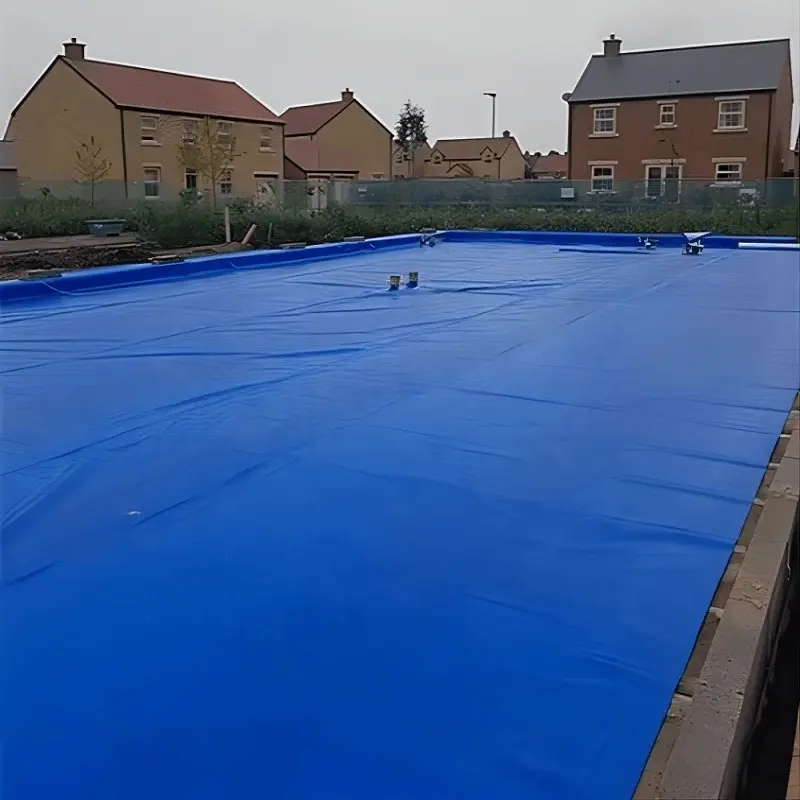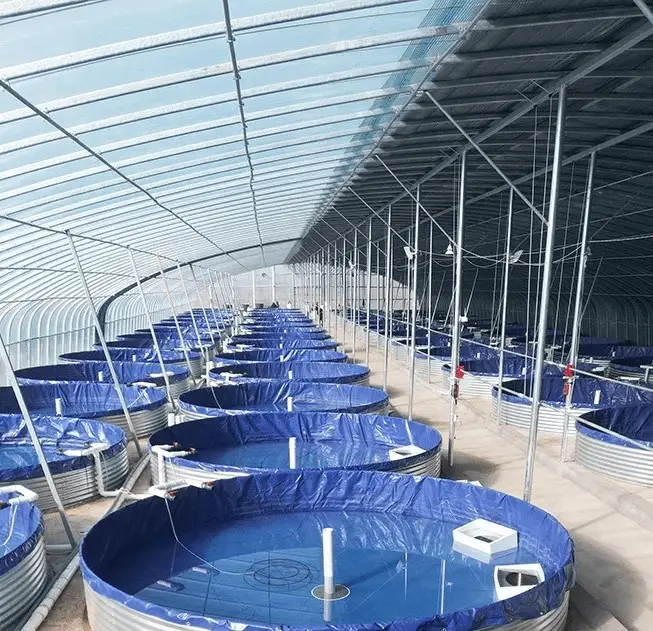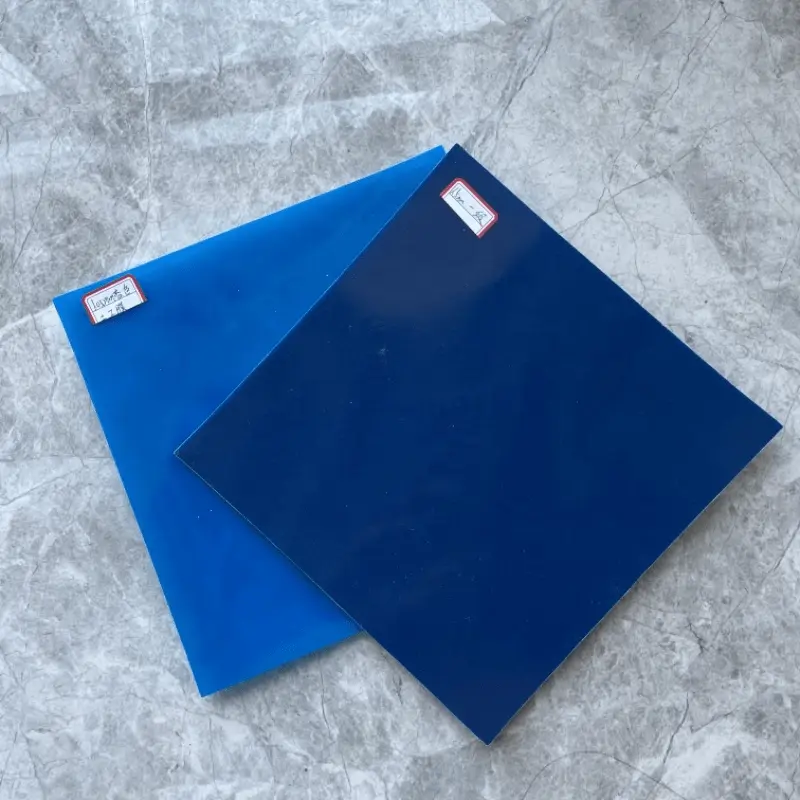Technical Specifications of 1mm Blue PVC Geomembrane
The performance of a geomembrane depends on its material composition and thickness. Below is a detailed table outlining the key properties of a standard 1mm blue PVC geomembrane:
| Parameter | Specification |
|---|---|
| Thickness | 1.0 mm (±5%) |
| Density | 1.4 g/cm³ |
| Tensile Strength (MD/TD) | 25 MPa / 25 MPa |
| Elongation at Break (MD/TD) | 300% / 280% |
| Tear Resistance (N) | 120 N (ASTM D1004) |
| Carbon Black Content | 2–3% |
| UV Resistance | 70% retention after 1,600 hours (ASTM G154) |
| Operating Temperature | -30°C to 70°C |
| Puncture Resistance | 400 N (ASTM D4833) |
| Chemical Resistance | Resistant to acids, alkalis, and salts |
Note: MD = Machine Direction; TD = Transverse Direction. Specifications may vary slightly based on manufacturing processes.

Key Applications of 1mm Blue PVC Geomembrane
1. Landfill Liners and Covers
Landfills require impermeable barriers to prevent leachate—toxic liquid generated by decomposing waste—from contaminating soil and groundwater. A 1mm blue PVC geomembrane serves as a reliable liner due to its:
Chemical Resistance: Withstands harsh leachate components.
UV Stability: The blue pigment includes UV stabilizers, ensuring longevity in outdoor exposure.
Cost Efficiency: Thinner than HDPE alternatives (e.g., 1.5mm or 2mm), reducing material costs while meeting regulatory standards.
Case Study: A municipal solid waste landfill in Europe used 1mm blue PVC geomembranes for its final cover system. Over five years, the liner maintained 98% integrity, with minimal degradation from UV exposure or chemical seepage.
2. Mining Industry: Heap Leach Pads & Tailings Ponds
In mining operations, geomembranes line heap leach pads (to contain cyanide solutions) and tailings ponds (to manage waste slurry). The 1mm blue PVC variant is ideal for:
Flexibility: Conforms to uneven terrain, reducing installation time.
Puncture Resistance: Withstands heavy machinery and sharp ore particles.
Thermal Stability: Operates effectively in extreme climates (-30°C to 70°C).
Data Insight: A 2022 study by the International Journal of Mining Science reported that 1mm PVC geomembranes reduced seepage rates by 92% in gold heap leach operations compared to unlined pads.
3. Aquaculture: Fish Farms and Ponds
Aquaculture projects prioritize water retention and algae control. The blue hue of 1mm PVC geomembranes offers dual benefits:
Algae Suppression: Blue surfaces reflect specific light wavelengths, inhibiting algae growth.
Durability: Resistant to fish waste, disinfectants, and UV degradation.
Example: A commercial tilapia farm in Southeast Asia adopted 1mm blue PVC liners, achieving a 15% increase in water retention efficiency and 30% lower maintenance costs over three years.
4. Agriculture: Irrigation Reservoirs and Canals
Farmers use 1mm blue PVC geomembranes to line irrigation ponds and canals, ensuring:
Water Conservation: Prevents seepage loss (up to 95% efficiency).
Chemical Resistance: Withstands fertilizers and pesticides.
Ease of Installation: Lightweight and weldable, reducing labor costs.
Statistical Highlight: The U.S. Department of Agriculture estimates that lined irrigation systems save 20–40% more water than unlined systems.
5. Decorative and Architectural Applications
The vibrant blue color and 1mm thickness make this geomembrane suitable for:
Ornamental Ponds: Aesthetic appeal with minimal maintenance.
Roof Gardens: Waterproofing for green roofs while supporting plant growth.
Playgrounds: Safe, cushioned surfaces under equipment.
Design Tip: Architects often combine blue PVC liners with decorative stones or fountains to create visually striking water features.

Advantages of 1mm Blue PVC Geomembrane
1. Durability and Longevity
With a lifespan of 20–30 years in typical conditions, 1mm PVC geomembranes outperform alternatives like HDPE in UV resistance and flexibility.
2. Cost-Effectiveness
Thinner than HDPE (1.5mm–2mm) but thicker than reinforced polyethylene (0.5mm), 1mm PVC strikes a balance between material costs and performance.
3. Ease of Installation
Lightweight: Simplifies handling and welding.
Weldability: Seams can be fused using hot air or extrusion welding, ensuring leak-proof joints.
4. Environmental Benefits
Reduces Contamination: Prevents soil and water pollution in landfills and mining sites.
Water Conservation: Minimizes waste in agriculture and aquaculture.
Case Study: Wastewater Treatment Lagoon
A municipal wastewater treatment plant in Australia replaced its aging clay liner with a 1mm blue PVC geomembrane. Key outcomes:
Reduced Seepage: From 1,200 liters/day to 45 liters/day.
Cost Savings: 40% lower installation costs compared to HDPE.
Maintenance: Zero repairs needed over five years due to the material’s puncture resistance.
Conclusion
The 1mm blue PVC geomembrane is a versatile solution for industries requiring reliable, cost-effective containment. Its technical specifications—chemical resistance, UV stability, and flexibility—make it suitable for landfills, mining, aquaculture, and beyond. As environmental regulations tighten and water conservation becomes critical, the demand for such geomembranes will only grow. By combining durability with aesthetic appeal, the 1mm blue PVC variant remains a top choice for engineers and project managers worldwide.

897.webp)
942.webp)
237.webp)